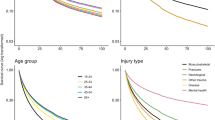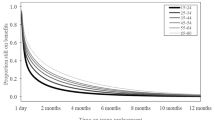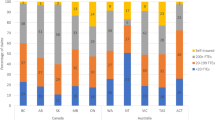Abstract
Purpose
Workers’ compensation claims consist of occupational injuries severe enough to meet a compensability threshold. Theoretically, systems with higher thresholds should have fewer claims but greater average severity. For research that relies on claims data, particularly cross-jurisdictional comparisons of compensation systems, this results in collider bias that can lead to spurious associations confounding analyses. In this study, I use real and simulated claims data to demonstrate collider bias and problems with methods used to account for it.
Methods
Using Australian claims data, I used a linear regression to test the association between claim rate and mean disability durations across Statistical Areas. Analyses were repeated with nesting by state/territory to account for variations in compensability thresholds across compensation systems. Both analyses are repeated on left-censored data. Simulated claims data are analysed with Cox survival analyses to illustrate how left-censoring can reverse effects.
Results
The claim rate within a Statistical Area was inversely associated with disability duration. However, this reversed when Statistical Areas were nested by state/territory. Left-censoring resulted in an attenuation of the unnested association to non-significance, while the nested association remained significantly positive. Cox regressions with simulated claims data demonstrated how left-censoring can reverse effects.
Conclusions
Collider bias can seriously confound work disability research, particularly cross-jurisdictional comparisons. Work disability researchers must grapple with this challenge by using appropriate study designs and analytical approaches, and considering how it affects the interpretation of results.




Similar content being viewed by others
Data Availability
Case-level claims data contain potentially re-identifiable data and therefore cannot be publicly shared. Aggregate-level claims data used, NBA player data, and simulated data have been archived have all available on a public repository [27].
Code Availability
All cleaning, data simulation, and analytical code have been archived on a public repository [27].
References
Rohrer JM. Thinking clearly about correlations and causation: graphical causal models for observational data. Adv Methods Pract Psychol Sci. 2018;1(1):27–42.
Pearl J, Mackenzie D. The book of why: the new science of cause and effect. New York, NY: Basic Books; 2018.
Lee H, Aronson JK, Nunan D. Collider bias. In: Catalogue of bias. 2019. https://catalogofbias.org/biases/collider-bias/.
Elwert F, Winship C. Endogenous selection bias: the problem of conditioning on a collider variable. Annu Rev Sociol. 2014;40:31–53.
Hahn M. You can be a professional basketball player, no matter how tall you are! No correlation between height and scoring success in the NBA: https://t.co/C1XpivlhQc. @3rdreviewer. 2017. https://twitter.com/3rdreviewer/status/840266678076350464. Accessed 2 Dec 2020.
NBA Media Ventures LLC. NBA Advanced Stats - Stats Home / Players / Bio. 2020. https://stats.nba.com/players/bio/?Season=2018-19&SeasonType=RegularSeason&sort=PLAYER_NAME&dir=1. Accessed 9 Sep 2020.
Australian Bureau of Statistics. 6324.0 Work-related injuries, Australia, Jul 2017 to Jun 2018. 2018. https://www.abs.gov.au/ausstats/abs@.nsf/mf/6324.0. Accessed 7 May 2020.
Shraim M, Cifuentes M, Willetts JL, Marucci-Wellman HR, Pransky GS. Length of disability and medical costs in low back pain: do state workers’ compensation policies make a difference? J Occup Environ Med. 2015;57(12):1275–1283.
Safe Work Australia. Comparison of Workers’ Compensation Arrangements in Australia and New Zealand. Canberra: Safe Work Australia; 2019. https://www.safeworkaustralia.gov.au/doc/comparison-workers-compensation-arrangements-australia-and-new-zealand-2019.
Spieler EA, Burton JF. The lack of correspondence between work-related disability and receipt of workers’ compensation benefits. Am J Ind Med. 2012;55(6):487–505.
Lax MB, Manetti FA, Klein RA. Medical evaluation of work-related illness: evaluations by a treating occupational medicine specialist and by independent medical examiners compared. Int J Occup Environ Health. 2004;10(1):1–12.
Krause N, Dasinger LK, Deegan LJ, Rudolph L, Brand RJ. Psychosocial job factors and return-to-work after compensated low back injury: a disability phase-specific analysis. Am J Ind Med. 2001;40(4):374–392.
Dasinger LK, Krause N, Deegan LJ, Brand RJ, Rudolph L. Physical workplace factors and return to work after compensated low back injury: a disability phase-specific analysis. J Occup Environ Med. 2000;42(3):323–333.
Kilgour E, Kosny A, McKenzie D, Collie A. Healing or harming? Healthcare provider interactions with injured workers and insurers in workers’ compensation systems. J Occup Rehabil. 2015;25(1):220–239.
Kilgour E, Kosny A, McKenzie D, Collie A. Interactions between injured workers and insurers in workers’ compensation systems: a systematic review of qualitative research literature. J Occup Rehabil. 2015;25(1):160–181.
Kilgour E, Kosny A, Akkermans A, Collie A. Procedural justice and the use of independent medical evaluations in workers’ compensation. Psychol Inj Law. 2015;8(2):153–168.
Collie A, Lane TJ, Hassani-Mahmooei B, Thompson J, McLeod C. Does time off work after injury vary by jurisdiction? A comparative study of eight Australian workers’ compensation systems. BMJ Open. 2016;6(5):e010910.
Lane TJ, Sheehan LR, Gray SE, Collie A. Regional differences in time off work after injury: a comparison of Australian states and territories within a single workers compensation system. Occup Environ Health. 2020. https://doi.org/10.1101/2020.07.23.20160416.
Lane TJ, Sheehan LR, Gray SE, Beck D, Collie A. Step-downs reduce workers compensation payments to encourage return to work. Are they effective? Occup Environ Med. 2020;77:470–477.
Sears JM, Heagerty PJ. Including injured workers without compensated time loss in Cox regression models: analyzing time loss using all available data. J Occup Rehabil. 2008;18(3):225–232.
Collie A, Lane TJ. Australian workers’ compensation systems. In: Willis E, Reynolds L, Judge T, editors. Understanding the Australian Health Care System. 4th ed. Chatswood, NSW: Elsevier Australia; 2019. p. 208–222.
Lippel K, Lötters F. Public insurance systems: a comparison of cause-based and disability-based income support systems. In: Loisel P, Anema JR, editors. Handbook of work disability. New York, NY: Springer; 2013. p. 183–202.
Lane TJ, Collie A, Hassani-Mahmooei B. Work-related injury and illness in Australia, 2004 to 2014. Melbourne: AU; 2016.
Safe Work Australia. National data set for compensation-based statistics, 3rd ed. Canberra: AU; 2004.
Australian Bureau of Statistics. 1270.0.55.001 - Australian Statistical Geography Standard (ASGS): Volume 1—Main Structure and Greater Capital City Statistical Areas, July 2016. 2016. https://www.abs.gov.au/ausstats/abs@.nsf/Lookup/bySubject/1270.0.55.001~July 2016~Main Features~Statistical Area Level 4 (SA4)~10016. Accessed 30 July 2020.
Australian Government. Employment Region Data. Labour Market Information Portal. 2020. https://lmip.gov.au/default.aspx?LMIP/Downloads/EmploymentRegion. Accessed 29 July 2020.
Lane TJ. Cross-jurisdictional comparisons using workers’ compensation: illustrating collider bias due to compensability thresholds—data and code. Bridges. 2021. https://doi.org/10.26180/13140374.
R Core Team. R: a language and environment for statistical computing. Vienna, Austria: R Foundation for Statistical Computing; 2020.
RStudio Team. RStudio: integrated development for R. Boston, MA: RStudio, Inc.; 2020.
Robinson D, Hayes A. broom: convert statistical analysis objects into tidy tibbles. 2020.
Bolker B, Robinson D. broom.mixed: tidying methods for mixed models. 2020.
Firke S. janitor: simple tools for examining and cleaning dirty data. 2020.
Grolemund G, Wickham H. Dates and times made easy with lubridate. J Stat Softw. 2011;40(3):1–25.
Ooms J. magick: advanced graphics and image-processing in R. 2021. https://CRAN.R-project.org/package=magick
Bache SM, Wickham H. magrittr: a forward-pipe operator for R. 2014.
Pinheiro J, Bates D, DebRoy S, Sarkar D, R Core Team. nlme: linear and nonlinear mixed effects models. 2020.
Wickham H, Bryan J. readxl: Read excel files. 2019.
Lüdecke D, Makowski D, Waggoner P, Ben-Shachar MS. see: Visualisation Toolbox for “easystats” and Extra Geoms, Themes, and Color Palettes for “ggplot2”. 2019.
Pebesma E. Simple features for R: standardized support for spatial vector data. R J. 2018;10(1):439–446.
Wickham H. tidyverse: Easily Install and Load the “Tidyverse.” 2017.
Zeileis A, Grothendieck G. zoo: S3 infrastructure for regular and irregular time series. J Stat Softw. 2005;14(6):1–27.
Pearl J. Comment: understanding Simpson’s paradox. Am Stat. 2014;68(1):8–13.
Hernán MA, Clayton D, Keiding N. The Simpson’s paradox unraveled. Int J Epidemiol. 2011;40(3):780–785.
Stovitz SD, Banack HR, Kaufman JS. ‘Depletion of the susceptibles’ taught through a story, a table and basic arithmetic. BMJ Evid-Based Med. 2018;23(5):199.
Shadish WR, Cook TD, Campbell DT. Experimental and quasi-experimental designs for generalized causal inference. Boston, MA: Houghton Mifflin; 2002.
Krause N, Frank JW, Dasinger LK, Sullivan TJ, Sinclair SJ. Determinants of duration of disability and return-to-work after work-related injury and illness: challenges for future research. Am J Ind Med. 2001;40(4):464–484.
Lane TJ, Gray SE, Hassani-Mahmooei B, Collie A. Effectiveness of employer financial incentives in reducing time to report worker injury: an interrupted time series study of two Australian workers’ compensation jurisdictions. BMC Public Health. 2018;18(100):1–10.
Collie A, Beck D, Gray SE, Lane TJ. Impact of legislative reform on benefit access and disability duration in workers’ compensation: an interrupted time series study. Occup Environ Med. 2020;77(1):32–39.
Pollak C. The impact of a sick pay waiting period on sick leave patterns. Eur J Health Econ. 2017;18(1):13–31.
Lane TJ, Collie A. Geographic variation in work disability burden: Identifying hotspots, coldspots, and associated sociodemographic factors. Am J Ind Med. 2021. https://doi.org/10.1002/ajim.23253.
Acknowledgements
I would like to thank my supervisor and editor of this special edition, Professor Alex Collie, for his comments on an earlier version of this manuscript.
Funding
This study was funded by an Australian Research Council Discovery Project Grant (DP190102473), as part of the Compensation and Return to Work Effectiveness (COMPARE) Project, and by Safe Work Australia, a government statutory agency that develops national work health and safety and workers’ compensation policy.
Author information
Authors and Affiliations
Contributions
This paper is the sole work of TJL.
Corresponding author
Ethics declarations
Conflict of interest
The author previously received salary support from funding provided by the workers’ compensation systems investigated in this study.
Ethical Approval
This study received ethics approval from the Monash University Human Research Ethics Committee (CF14/2995 – 2014001663).
Additional information
Publisher's Note
Springer Nature remains neutral with regard to jurisdictional claims in published maps and institutional affiliations.
Supplementary Information
Below is the link to the electronic supplementary material.
Rights and permissions
About this article
Cite this article
Lane, T.J. Collider Bias in Administrative Workers’ Compensation Claims Data: A Challenge for Cross-Jurisdictional Research. J Occup Rehabil 32, 161–169 (2022). https://doi.org/10.1007/s10926-021-09988-1
Accepted:
Published:
Issue Date:
DOI: https://doi.org/10.1007/s10926-021-09988-1




